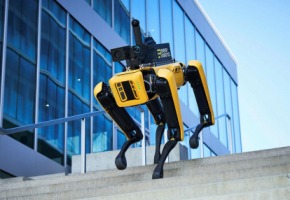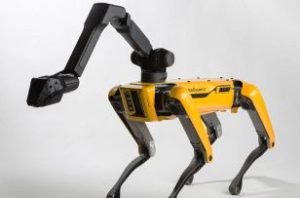THE EMERGING ROBOT-DOG EAT POLICE-DOG WORLD

Dogs have been helping police solve crimes since the middle ages. An impression that dogs are indispensable and irreplaceable in many police and military organisations seemed a reality until I recently watched the movie A.X.L. However, A.X.L., a 2018 American sci-fi adventure film, featured a top-secret robot-dog developed using groundbreaking military technology to protect tomorrow’s soldiers. Built by Crane Systems and code-named A.X.L., which denotes Attack, Exploration and Logistics, the robot-dog symbolised the most avant-garde next-generation artificial intelligence. The film narrates the tale of a teenage boy named Miles Hill discovering a damaged A-X-L hiding in a remote desert after the robot had been in an experiment that had gone wrong in the military facility. The teenage boy manages to connect with the robot dog after activating his owner-pairing technology. In time, the robot dog becomes intensely attached to the adolescent kid and is prepared to go to any lengths to save him from all danger.
 Further, a little exploration of the subject revealed that the New York Police Department (NYPD), Massachusetts State Police and the Honolulu Police Department had recently begun using robot dogs to accompany them during patrols, remotely defuse bombs and fight crimes. Singapore, too, is using robot dogs to patrol and maintain social distancing during the current pandemic. Robot dogs are robots that look like dogs with four-legged mobility that can perform a variety of tasks. They are partly autonomous ground vehicles with artificial intelligence. As the robot dogs do not need a dedicated handler, don’t rest, don’t need diet as sunshine is all that is required to charge their batteries and don’t poop. Robot-dogs are threatening to become a ‘pawfect’ replacement for our police canines.
Further, a little exploration of the subject revealed that the New York Police Department (NYPD), Massachusetts State Police and the Honolulu Police Department had recently begun using robot dogs to accompany them during patrols, remotely defuse bombs and fight crimes. Singapore, too, is using robot dogs to patrol and maintain social distancing during the current pandemic. Robot dogs are robots that look like dogs with four-legged mobility that can perform a variety of tasks. They are partly autonomous ground vehicles with artificial intelligence. As the robot dogs do not need a dedicated handler, don’t rest, don’t need diet as sunshine is all that is required to charge their batteries and don’t poop. Robot-dogs are threatening to become a ‘pawfect’ replacement for our police canines.
 Boston Dynamics, a robotics company, founded by former M.I.T. professor Marc Raibert, launched a Robot-dog called Spot in 2015, intending to turn it into a commercial product, and began marketing them summer 2020. The NYPD has recently acquired a 70-pound Spot robot dog and nicknamed it “Digidog”. Users can control Spot using a remote control to walk or navigate in space. We can also program it to follow a specific route. The Spot is an agile, mobile robot with unprecedented mobility, that permits automated routine inspection tasks and capturing of data safely, accurately, and frequently. Spot can not just walk on a flat surface, it can climb stairs, avoid obstacles and move through grass and gravel. It can hold about 30 pounds of equipment and has an arm that allows it to open doors.
Boston Dynamics, a robotics company, founded by former M.I.T. professor Marc Raibert, launched a Robot-dog called Spot in 2015, intending to turn it into a commercial product, and began marketing them summer 2020. The NYPD has recently acquired a 70-pound Spot robot dog and nicknamed it “Digidog”. Users can control Spot using a remote control to walk or navigate in space. We can also program it to follow a specific route. The Spot is an agile, mobile robot with unprecedented mobility, that permits automated routine inspection tasks and capturing of data safely, accurately, and frequently. Spot can not just walk on a flat surface, it can climb stairs, avoid obstacles and move through grass and gravel. It can hold about 30 pounds of equipment and has an arm that allows it to open doors.
 The NYPD Digidog has an average walking speed of a human which is 1.6 meters per second. We may easily outrun Spot. Another robot built by Wildcat can run about 20 miles per hour. Digidog has five depth cameras that enable 360 degrees vision around the robot, both in daylight and in the dark. It’s in-body force sensors and various optimisation algorithms help it in navigation and detection. Operating a Digidog through remote control is like playing a video game. A built-in docking system helps the robotic dog to return home upon pushing a button to recharge its batteries. It also has a pre-programmed route function, and we can also navigate it by conveying commands. The Spot is available for sale today at a starting price of $74,500.
The NYPD Digidog has an average walking speed of a human which is 1.6 meters per second. We may easily outrun Spot. Another robot built by Wildcat can run about 20 miles per hour. Digidog has five depth cameras that enable 360 degrees vision around the robot, both in daylight and in the dark. It’s in-body force sensors and various optimisation algorithms help it in navigation and detection. Operating a Digidog through remote control is like playing a video game. A built-in docking system helps the robotic dog to return home upon pushing a button to recharge its batteries. It also has a pre-programmed route function, and we can also navigate it by conveying commands. The Spot is available for sale today at a starting price of $74,500.
 Since February this year, NYPD has commenced testing the Digidog they procured recently in New York City. In February, two men were held hostage, threatened at gunpoint, tied up and tortured for hours in a Bronx apartment by two other men who had infiltrated the apartment under the guise of plumbers. One victim luckily could break free from the clutches of the armed men and establish contact with the police. When the police responded to his call and arrived at the scene, they were unsure if the armed men were still lurking inside the apartment. Hence, the police deployed the Digidog to prevent themselves from a dangerous situation of being shot inside the darkroom. As the robot could enable the police to remotely view the room even in pitch darkness with its night vision cameras. The pictures streamed by the dog robot helped the police realise that the armed men had fled from the apartment after burning one victim with a soldering rod and stealing a mobile and $2000 in cash.
Since February this year, NYPD has commenced testing the Digidog they procured recently in New York City. In February, two men were held hostage, threatened at gunpoint, tied up and tortured for hours in a Bronx apartment by two other men who had infiltrated the apartment under the guise of plumbers. One victim luckily could break free from the clutches of the armed men and establish contact with the police. When the police responded to his call and arrived at the scene, they were unsure if the armed men were still lurking inside the apartment. Hence, the police deployed the Digidog to prevent themselves from a dangerous situation of being shot inside the darkroom. As the robot could enable the police to remotely view the room even in pitch darkness with its night vision cameras. The pictures streamed by the dog robot helped the police realise that the armed men had fled from the apartment after burning one victim with a soldering rod and stealing a mobile and $2000 in cash.
 Similarly, in another incident a squabble over a parking place climaxed with a bullet being shot into the head of a soldier’s wife. A 43-year-old man involved in the spat opened fire with his gun, putting a bullet into the head of a 42-year-old woman instead of her husband, the intended target. The shooter then darted into a nearby house and barricaded himself. The NYPD’s Emergency Services Unit responded with the Digidog, which assisted the police in taking the suspect into custody.
Similarly, in another incident a squabble over a parking place climaxed with a bullet being shot into the head of a soldier’s wife. A 43-year-old man involved in the spat opened fire with his gun, putting a bullet into the head of a 42-year-old woman instead of her husband, the intended target. The shooter then darted into a nearby house and barricaded himself. The NYPD’s Emergency Services Unit responded with the Digidog, which assisted the police in taking the suspect into custody.
The Digidog also came in handy at Queens in a tense scene where two armed men held five people captive at home. People held hostage demanded food, so the police strapped food to the Digidog and sent it to the location.
The ostensibly utopian Robot-dog could turn dystopian in the near future. The hazards of dystopian law enforcement prevail because of the likelihood of robots becoming weaponised in future and their possible metamorphosis from a remote-controlled device to an independent decision-maker. With the danger of Dog robots becoming armed and autonomous being the ultimate nightmare. Such dystopian scenarios are a good reason for us to feel uneasy. A reflection of such a scenario was made evident in an episode of ‘Metalhead.’ where a robot dog hunts a speeding van, slams through the van’s back window, and obliterates the driver’s head with a deadly gunshot. Boston Dynamics, the manufacturers of the robot dog, insist that the use of Digidog as a weapon was unlikely. But they were proved wrong by some activists who demonstrated how the robot could be weaponised by mounting toy guns and having them fire at targets. The Dallas police department has already exhibited the way for the future of weaponised robot policing. In 2016, the Dallas Police Department made use of a robot equipped with a bomb to bump off Micah Johnson, an ex-army man, after he had killed five police officers in retribution for the deaths of the blacks by the police. Micah, who became the first man to be killed by a robot, was coincidentally black.
Dog robots are not just accomplishing policing and security duties. They are also conducting funerals for pet dogs in Japan. Some robots are being used as priests and are performing services in Churches and pujas in temples. Shintoism believes plants, animals, rocks, and artificial devices like robots and our environment possesses a spiritual essence, although most religions can accept immortal souls only in human beings. As more religions integrate robotics, we can expect changes in the way people experience faith, worship and reason ethically.
Source from: epaper/dtnext/chennai/dt:25.04.2021
 Dr.K. Jayanth Murali is an IPS Officer belonging to 1991 batch. He is borne on Tamil Nadu cadre. He lives with his family in Chennai, India. He is currently serving the Government of Tamil Nadu as Additional Director General of Police, Law and Order.
Dr.K. Jayanth Murali is an IPS Officer belonging to 1991 batch. He is borne on Tamil Nadu cadre. He lives with his family in Chennai, India. He is currently serving the Government of Tamil Nadu as Additional Director General of Police, Law and Order.



May 3, 2021 at 5:30 PM /
Keep going to write so useful articles and also good that you have a lot of people who visits your website I can say it basede on the reviews you have here.
דירות דיסקרטיות בתל אביב